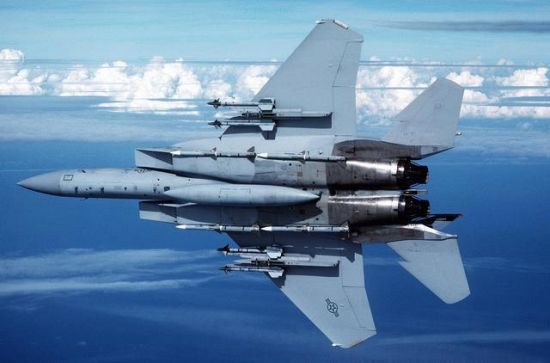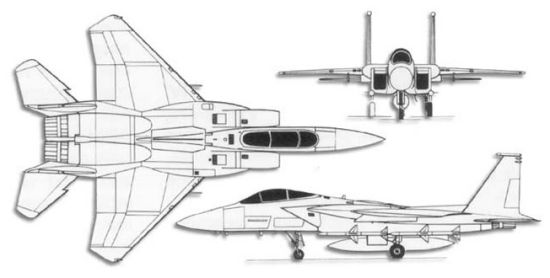|
||||||||||
|
|
||||||||||
|
||||||||||
|
|
||||||||||
 - -
|
|

|
McDonnell Douglas (now Boeing) F-15 Eagle Air Superiority Fighter |
|
DESCRIPTION:
Forseeing the need to replace its fleet of F-4 Phantoms, the US Air Force issued the FX requirement for a long-range air superiority fighter in 1965. Performance requirements called for beyond visual range air-to-air capability, close-in dogfighting capability, twin engines, an internal gun, sufficient ferry range to deploy to Europe without refueling, and a maximum speed of Mach 2.5. McDonnell Douglas was selected over rivals North American and Fairchild Republic to build what would become the F-15 Eagle. The McDonnell Douglas approach incorporated advanced aerodynamics into a large wing that gives the F-15 a low wing loading and good agility for such a large aircraft. However, transonic buffet and flutter problems were encountered in early flight tests requiring an enlarged airbrake, cropping of the trailing edges of the wingtips, and adding notched dogtooths to the tailplanes. The addition of external compression adjustable inlets and the extensive use of titanium allowed the F-15 to meet its Mach 2.5 speed requirement at high altitude, though the speed is limited to Mach 1.78 when armed. The F-15 revolutionized cockpit design by seating the pliot high under a large canopy to provide excellent visibility, and the use of a Hands On Throttle and Stick (HOTAS) arrangement places all vital controls near the pilots hands. Although the Air Force had originally intended to order some 730 F-15A single-seat fighters and F-15B two-seat combat-capable trainers, only about 410 were built before production switched to the more capable F-15C/D models. These newer aircraft feature a new radar warning receiver, software updates, and conformal fuel tanks along the sides of the engine inlets that provide increased fuel capacity while not interfering with weapons carriage. Later F-15C/D models also received more powerful F100-220 engines plus the faster APG-70 radar with better resolution and greater memory when compared to the earlier APG-63. Older F-15A/B and F-15C/D models have also been progressively upgraded through an ambitious Mid-Service Improvement Program (MSIP). Among the updates include upgrading to newer variants of the APG-63 radar, intoducing new avionics, and replacing outdated analog computers with digital central processors. Other advances include adding a new weapons display screen, improving internal countermeasures, and adding compatibility with the AIM-120 AMRAAM. The potential of the basic F-15 airframe has been further exploited through the development of the two-seat F-15E strike model that adds a potent surface attack capability. Older F-15A/C vehicles will begin to be replaced by the F-22 by about 2010, and some of the displaced fighters will likely be converted for use as air defense suppression aircraft.
Data below for F-15C |
|
| HISTORY: | |
| First Flight |
(F-15A) 27 July 1972 (F-15B) 7 July 1973 (F-15C) 26 February 1979 (F-15D) 19 June 1979 |
|
Service Entry
|
(F-15A) 9 January 1976 (F-15B) 14 November 1974 (F-15C) September 1979 (F-15D) December 1979 |
| CREW: |
(F-15A/C) one: pilot (F-15B/D) two: pilot, instructor |
|
ESTIMATED COST:
|
(F-15A/B) $27.9 million [1998$] (F-15C/D) $29.9 million [1998$] |
| AIRFOIL SECTIONS: | |
| Wing Root | NACA 64A(.055)5.9 |
|
Wing Tip
|
NACA 64A203
|
| DIMENSIONS: | |
| Length | 63.75 ft (19.43 m) |
| Wingspan | 42.81 ft (13.05 m) |
| Height | 18.46 ft (5.63 m) |
| Wing Area | 608 ft² (56.48 m²) |
|
Canard Area
|
not applicable
|
| WEIGHTS: | |
| Empty | 28,600 lb (12,975 kg) |
| Normal Takeoff |
(F-15A) 41,500 lb (18,885 kg) (F-15C) 44,630 lb (20,245 kg) |
| Max Takeoff |
(F-15A) 56,000 lb (25,400 kg) (F-15C) 68,000 lb (30,845 kg) |
| Fuel Capacity |
(F-15A) internal: 11,600 lb (5,260 kg) external: 11,895 lb (5,395 kg) (F-15C) internal: 13,455 lb (6,105 kg) external: 9,750 lb (4,425 kg) |
|
Max Payload
|
(F-15A) 16,000 lb (7,260 kg) (F-15C) 16,000 lb (7,260 kg) with conformal fuel tanks (F-15C) 23,600 lb (10,705 kg) without conformal fuel tanks |
| PROPULSION: | |
| Powerplant |
(F-15A) two Pratt & Whitney F100-100 afterburning turbofans (F-15C) two Pratt & Whitney F100-220 afterburning turbofans |
| Thrust |
(F-15A) 29,340 lb (130.52 kN) (F-15A) 47,660 lb (212.0 kN) with afterburner (F-15C) 29,340 lb (130.52 kN) (F-15C) 47,660 lb (212.0 kN) with afterburner |
| PERFORMANCE: | |
| Max Level Speed |
at altitude: 1,665 mph (2,655 km/h) at 36,000 ft (10,975 m), Mach 2.5 at sea level: unknown cruise speed: 570 mph (915 km/h) |
| Initial Climb Rate | 50,000 ft (15,240 m) / min |
| Service Ceiling |
65,000 ft (19,810 m) 100,000 ft (30,840 m) [absolute ceiling] |
| Range |
typical: 2,120 nm (3,930 km) ferry: 2,500 nm (4,630 km) without conformal fuel tanks ferry: 3,100 nm (5,745 km) with conformal fuel tanks |
| Endurance |
5 hr 15 min with conformal fuel tanks 15 hr with in-flight refueling |
| g-Limits |
+9 / -3
|
| ARMAMENT: | |
| Gun | one 20-mm M61A1 Vulcan cannon (940 rds) |
| Stations | seven external hardpoints |
| Air-to-Air Missile | AIM-7 Sparrow, AIM-9 Sidewinder, AIM-120 AMRAAM, Python 3, Python 4 |
| Air-to-Surface Missile | AGM-88 HARM |
| Bomb | none |
| Other |
ECM pods
|
| KNOWN VARIANTS: | |
| F-15A | Production single-seat fighter; 355 built |
| F-15B or TF-15A | Two-seat combat-capable trainer; 57 built |
| F-15C | Upgraded one-seat fighter with updated avionics and conformal fuel tanks vastly improving the aircraft's range; 408 built |
| F-15D | Upgraded two-seat combat-capable trainer based on the F-15C; 61 built |
| F-15E | Two-seat multi-role fighter with ground attack capability provided by a synthetic aperture radar, LANTIRN targeting pods containing FLIR and terrain-following radar equipment, and increased weapons load; 209 built |
| F-15F | Proposed single-seat fighter based on the F-15E airframe incoporating the F-15E's new engines, radar, and cockpit displays, Saudi Arabia originally ordered 24 of these plus 48 two-seat combat-capable trainer models; not built |
| F-15/HARM or F-15/PDF | Program proposed to convert F-15C/D airframes into defense suppression aircraft carrying HARM missiles; these Precision Direction Finder aircraft would be withdrawn, modified, and reintroduced as the F-22 enters service in the air superiority role |
| F-15 Baaz | Surplus USAF F-15A/B and new-build F-15C/D aircraft sold to Israel; at least 63 (35 F-15A, 2 F-15B, 18 F-15C, 8 F-15D) purchased |
| F-15J | Japanese fighter interceptor based on the F-15C but lacking the F-15C's ECM, radar warning, and nuclear delivery equipment, many license built by Mitsubishi; 211 built |
| F-15DJ | Japanese two-seat combat-capable trainer model based on the F-15D; 12 built |
| F-15 SMTD | F-15B airframe converted as a testbed for short take-off/landing and manuever technologies including thrust vectoring, canards, and advanced pilot interfaces, 138 flights completed between 1988 and 1991; 1 converted |
| F-15XP | Designation originally given to the F-15F single-seat and two-seat aircraft |
| F-15XX |
Proposed new-build F-15 with a new radar and various avionics improvements offered as a cheaper alternative
to the F-22; cancelled
|
|
KNOWN COMBAT RECORD:
|
shot down 5 Syrian MiG-21s (Israel, 1979) Iraq - Osirak nuclear reactor strike (Israel, 1981) Lebanon (Israel, 1982) shot down 2 Iranian F-4Es (Saudi Arabia, 1984) Tunisia - PLO headquarters strike (Israel, 1985) Iraq - Operation Desert Storm (USAF, Saudi Arabia, 1991) Iraq - Operation Northern Watch (USAF, 1991-2003) Iraq - Operation Southern Watch (USAF, 1991-2003) Bosnia - Operation Deliberate Force (USAF, 1995) Iraq - Operation Desert Fox (USAF, 1998) Kosovo - Operation Allied Force (USAF, 1999) US Homeland Security - Operation Noble Eagle (USAF, 2001-present) Afghanistan - Operation Enduring Freedom (USAF, 2001-present) Iraq - Operation Iraqi Freedom (USAF, 2003-present) |
|
KNOWN OPERATORS:
|
Israel, Tsvah Haganah le Israel - Heyl Ha'Avir (Israeli Defence Force - Air Force) Japan, Nihon Koku-Jieitai (Japan Air Self Defence Force) Saudi Arabia (Royal Saudi Army Air Arm) United States (US Air Force) United States (US Air National Guard) |
|
3-VIEW SCHEMATIC:

|
|
SOURCES:
|
|


|
Aircraft | Design | Ask Us | Shop | Search |

|
|
| About Us | Contact Us | Copyright © 1997-2023 | |||
|
|
|||